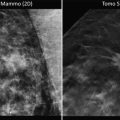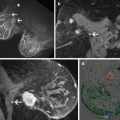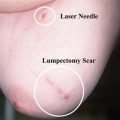Trial
Year
Disease
N
Treatment
Complete ablation
Complications
Jeffrey et al. [15]
1999
T3–T4 breast cancer or tumors >5 cm
5
Intraoperative RFA—mastectomy
80 %
None
Izzo et al. [16]
2001
T1–T2
26
US guided RFA (margin >5 mm)
96 % Coagulative necrosis
One full thickness skin burn
Singletary et al. [17]
2002
T2
30
Intraoperative RFA—excision
87 %
None
Burak et al. [18]
2003
≤2 cm
10
RFA—surgery 1–3 weeks later
Breast ecchymosis
Hayashi et al. [19]
2003
≤3 cm
10
RFA—surgery 1–2 weeks later
86 % Coagulative necrosis
Skin burn, mild discomfort
Fornage et al. [20]
2004
≤2 cm
21
RFA—surgery
95 % Coagulative necrosis
None
Noguchi et al. [21]
2006
≤2 cm
10
RFA—surgery
100 %
None
Earashi et al. [22]
2007
≤2 cm
24
RFA—surgery
100 %
None
Manenti et al. [23]
2009
≤2 cm
34
RFA—surgery 4 weeks later
97 % Coagulative necrosis
Hyperpigmentation/skin burn
Wiksell et al. [24]
2010
≤1.6 cm
31
RFA—surgery
84 % Complete necrosis
One skin burn, three chest wall burns, one pneumothorax
Kinoshita et al. [10]
2011
≤3 cm
50
RFA—surgery
61 % Complete ablation (83 % in tumors <2 cm)
Two skin burns, three muscle burns
Klimberg et al. [8]
2011
≤1.5 cm
15
Percutaneous excision (stereotactic or vacuum assisted device), percutaneous RFA, then surgery
100 %
None
Success of RF is governed by patient selection, with optimal patients having small well-defined unifocal lesions whose borders are clearly visible on US. RF is contraindicated in patients with multifocal or multicentric tumors, as well as DCIS and lobular cancers. MRI is useful to evaluate for mammographically occult multicentric disease or multifocal disease, since these patients are not optimal RF candidates. Again, a 1 cm distance from the skin or chest wall is also necessary. Other options for preoperative imaging include ultrasound and PET. Neoadjuvant chemotherapy is considered to be a contraindication for RFA, since it may produce nonhomogenous responses in the tumor bed [17].
It appears that efficacy of tumor ablation may be dependent on tumor size, with RFA more likely to completely ablate tumors <2 cm than in larger tumors over 2 cm. Kinoshita et al. demonstrated a complete ablation rate of 86 % in tumors less than 2 cm, and only 30 % in tumors over 2 cm [10]. This study also demonstrated the extensive intraductal component (EIC) makes it difficult to achieve complete ablation, as the rate of success was 39 % in those with EIC and 85 % in those with EIC. Interestingly, the authors suggest preoperative MRI/US to try and determine which patients have extensive EIC prior to proceeding with RFA [10].
Several studies involving RFA of small breast cancers without resection have been performed in Japan and France (Table 11.2) [25–30]. These studies are primarily in patients who are poor surgical candidates, and some include postprocedure radiation. After ablation, the cavity is subsequently percutaneously biopsied to follow the patient for recurrence. In Japan, Tamaki et al. performed RFA on 100 patients with a mean follow-up of 12 months. US guided FNA was done on the ablated lesions to assess for residual disease. Cosmesis was described as excellent in 83 % of cases, good in 12 %, and fair in 6 % [30].
Table 11.2
Trials of percutaneous RFA without resection (with or without radiation) and periodic biopsy of cavity
Trial | N | Assessment of ablated lesion | Length of follow-up | Outcome | Complications |
|---|---|---|---|---|---|
Oura et al. [25] | 52 | FNA biopsy | 15 months | One local recurrence | One skin burn |
Brkljacic et al. [26] | 6 | Routine (patients very ill) | 9–49 months | Two deaths from other causes | One infection |
Susini et al. [27] | 3 | Core | 18 months | No local recurrence | None |
Earashi et al. [20] | 6 | Mammotome | 4 months | No local recurrence | None |
Marcy et al. [28] | 4 | Core needle biopsy | 29 months | One local recurrence | One abscess |
Yamamoto et al. [29] | 29 | Vacuum-assisted core biopsy | 1 month | No local recurrence, no viable tumor in 24/26 patients | None |
Tamaki et al. [30] | 100 | FNA biopsy | 12 months | One local recurrence, one death from distant metastases | None |
The above studies noted that a hard lump may persist in the breast at the site of ablation for several months [25–30]. The majority of ablated tumors had shrunk considerably after 6 months, and within a year became occult on physical exam and ultrasound. One proposed option for tumors that persisted on mammography and ultrasound post ablation was excision via percutaneous biopsy devices (such as vacuum assisted devices).
Across most of the studies, increased tumor impedance (caused by increased fat content of tumors due to the high electrical resistance of fat) reduces the effectiveness of RFA. Since older patients have breast atrophy leading to a lower fat content of tumors compared to younger women, RFA may be more successful in older age groups due to reduced resistance to thermal energy. Again, this reinforces that RFA may be ideal for tumor ablation in the frail elderly population who are not good operative candidates [17, 31].
Stay updated, free articles. Join our Telegram channel

Full access? Get Clinical Tree








